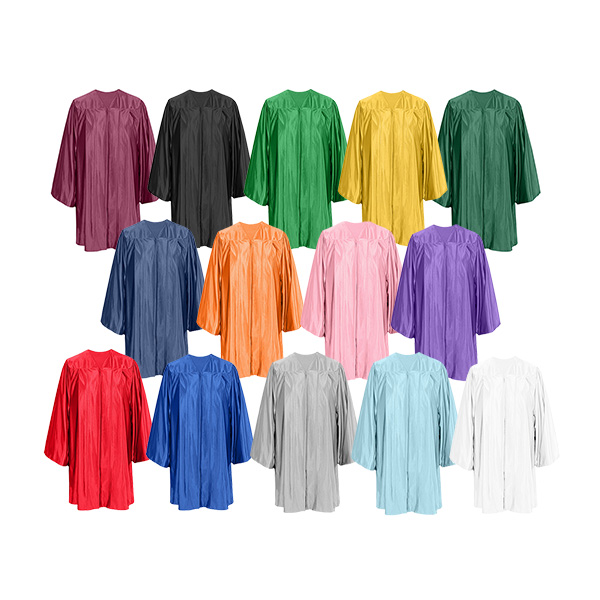The Psychology of Wearing Caps and Gowns
The Psychology of Wearing Caps and Gowns
Blog Article

The day of high school graduation is a pivotal milestone in a young person's life, marked by a mix of excitement, pride, and a hint of nostalgia. As students don their high school graduation caps and gowns, they step into a new chapter, leaving behind the familiar hallways of their school. These garments are not just fabric; they carry deep emotional significance and represent years of hard work, friendships, and personal growth.
Wearing caps and gowns serves as a powerful visual symbol of achievement and transition. The unique styles and colors often reflect the school’s traditions and values, creating a sense of unity among graduates. This collective experience fosters a shared identity, where each student feels part of something larger than themselves, making the ceremony all the more memorable. Understanding the psychology behind these garments can reveal insights into the significance of traditions that shape how graduates view their past and future.
Symbolism of Caps and Gowns
High school graduation caps and gowns serve as powerful symbols of achievement and transition. The cap, often referred to as a mortarboard, signifies the completion of an important educational journey. When students place this cap on their heads, they embody years of hard work, dedication, and growth. It represents not only the knowledge they have acquired but also the challenges they have overcome during their academic years.
The gown acts as a uniform that distinguishes graduates from the crowd, evoking a sense of unity among them. Clad in similar garments, graduates are united in their experience, illustrating that they have reached a collective milestone. This shared visual identity fosters camaraderie, reminding them that they are not alone in their journey. The gown symbolizes a rite of passage, marking their readiness to enter the next stage of their lives.
In addition to personal and communal significance, caps and gowns hold cultural importance. They connect current graduates to a long history of academic tradition, reflecting values such as perseverance and intellectual achievement. This attire transcends individual experiences, linking graduates to countless others who have donned similar robes throughout history, thus reinforcing the importance of education and societal contributions.
Psychological Impact on Graduates
Wearing high school graduation caps and gowns serves as a powerful symbol of achievement and transition. For many graduates, these garments represent years of hard work, perseverance, and personal growth. The moment of donning the cap and gown solidifies their identity as graduates and fosters a sense of pride, marking the conclusion of an important chapter in their lives. This recognition and celebration of their accomplishments can significantly boost self-esteem, reinforcing their belief in their abilities and potential.
High School Graduation Caps and Gowns
The ritual of graduation is steeped in tradition, contributing to a shared experience among graduates. While wearing caps and gowns, students enter a communal space where they can celebrate not only their individual successes but also the collective achievements of their peers. This shared experience fosters feelings of belonging and connection, important aspects of adolescent development. As they stand together in their caps and gowns, graduates are reminded that they are part of a larger community, which can alleviate feelings of isolation and encourage future collaboration.
Moreover, the psychological impact of high school graduation caps and gowns extends beyond the ceremony itself. For many, the transition to adulthood can be daunting, and the act of wearing these garments serves as a bridge between adolescence and the responsibilities of the next stage in life. Graduates often report feelings of optimism and excitement about their future, and the ritualistic nature of graduation can instill a sense of purpose. This emotional significance reinforces the importance of acknowledging milestones not just as endings, but as gateways to new opportunities.
Cultural Significance of Graduation Attire
High school graduation caps and gowns hold profound cultural significance, symbolizing a rite of passage for millions of students around the world. These garments represent the culmination of years of hard work, dedication, and academic achievement. The act of wearing these traditional outfits during graduation ceremonies serves as a powerful visual cue, marking the transition from adolescence to adulthood. It is a shared experience that fosters a sense of belonging among graduates, connecting them to their peers and the wider community.
The colors and designs of caps and gowns often reflect the unique identity of each educational institution, highlighting pride in school spirit and traditions. Different schools may have variations in color schemes or adornments, which can evoke a sense of nostalgia and collective memory for graduates. This attire not only signifies each individual's accomplishments but also embodies the values and history of the schools they represent. Thus, the fashion associated with graduation becomes a significant aspect of local and national culture.
Moreover, the act of donning these garments is steeped in ceremony and ritual, adding to their importance. The process of putting on a cap and gown invokes emotions of anticipation, celebration, and sometimes even sadness as students prepare to leave behind their high school years. These moments are often captured in photographs, further solidifying the emotional ties to this attire. In this manner, high school graduation caps and gowns transcend mere clothing, becoming lasting symbols of growth, achievement, and the profound journey undertaken by every graduate.
Report this page